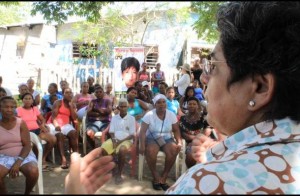EspañolColombia is at a crossroads, between two models that will define its future. The direction that the country will take depends on the relative weight that citizens give to two well-defined realities.
On the one hand, there is a Colombia that is moving along a path of wealth creation, which is growing, and therefore reducing poverty. On the other, there is a country that shows a completely different model, evident in the workings of the state and embodied in its incessant struggle for political power.
Unfortunately, the latter manifested itself in the results of the last parliamentary elections, held on March 9.

The day after the election, the Democratic Center Party leader, and former President Álvaro Uribe Vélez, denounced the existence of an alleged fraud. He was joined in this action by representatives of other parties such the Alternative Democratic Pole, MIRA, and the Green Party.
So far it has not been possible to verify whether or not such fraud occurred, as the counting process continues, but the total number of votes announced at the beginning has slowly changed as the review process has progressed. In addition to these allegations, though, there has been another one that is as troubling as the former: the parliamentary seats assigned to the black community were taken by two fair-skinned candidates, María del Socorro Bustamante and Moises Orozco.

Due to the affiliation of the elected candidates with “dark” characters of the country’s past, such as Enilce Lopez, also known as “La Gata,” it is very likely that this result is due to the use of threats of violence, or the buying of votes. Beyond speculation, which will have to be investigated by the courts, this fact shows several features of the second model and its negative effects.
First, there is the issue of unintended consequences. The 1991 Constitution contemplated the creation of special seats for ethnic minorities ー indigenous peoples and Afro-Colombians ー as a way to facilitate their participation in politics and to defend their interests. However, candidates who represent the interests of these minorities are no longer elected, and the seats have become political spoils without encouraging the creation of stable political organizations, particularly for the Afro-Colombian communities.
Whether well intentioned or not, these ethnic seats lead to three unfortunate but avoidable outcomes.
First, the state-based model grows, without solving the longstanding conflict. The creation of seats intended for ethnic minorities condemns these individuals not to see themselves as regular citizens, rather through the lens of marginalized groups. It is also a way to encourage a class struggle of sorts in Colombia, extrapolated to the ethnic area. Are the interests of indigenous or African communities different from those of other citizens? And if so, do all indigenous and African citizens have the same interests?
Second, the seats generate incentives that prevent change. Today, the discussion is about why the seats were won by people whose skin color does not correspond to that of those whom they claim to represent. However, it is not considered that the problem may be the very existence of those seats. Have we not become more racist and discriminatory when the whole discussion is about the skin color of the people involved?
Third, this has all become a means for the exclusion of these Colombian citizens, who have no access to the prosperity that many others are starting to enjoy. Bogotá, the economic center of Colombia, has the lowest poverty rate in the country, and rural areas have also begun to see the reversal of their historic situation of impoverishment. But Quibidó, capital of the Chocó department, where most of the black community resides, is still one of the poorest cities in the country.
So, while Colombia is generating good news in the economic sphere, the political arena shows a quite different picture: all one hears about is corruption, pettiness, excesses, poor transparency, and conflict. Clearly, the best for Colombian citizens, regardless of their ethnic origin, is to adhere to the first model and discard the second, which is dividing them against each other.
For some, it all begins with a discussion of whether to persist with strategies of positive discrimination, such as the ethnic seats. The evidence mounts, though, that becomes a non-issue. These seats don’t solve the problems for which they were created, increase conflict, and become sources of rents and corruption.
For all of us, overcoming exclusion begins with acknowledging that there still remains a lot to do towards deepening the only strategy that allows for wealth creation, a celebration of diversity, and the strengthening of cooperation among individuals: economic openness and the limits on the state.
 Versión Español
Versión Español












